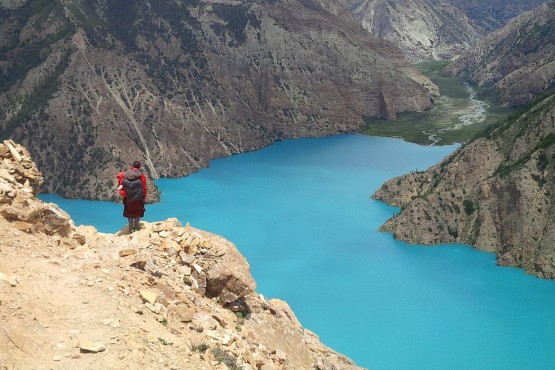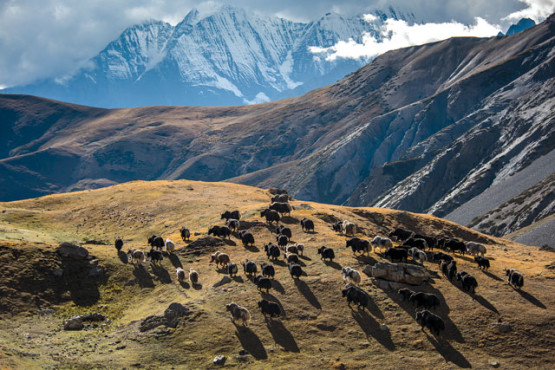Nepal is very rich in water resources; it is a known fact. There are hundreds of rivers, big and small streams, glaciers, lakes, and ponds in Nepal and most of them formed by the water streaming from the Himalayas. Along with the fact that sources of water are vital to us, they also hold religious importance in Nepali community. In Nepal, our religious belief is beyond the periphery of temples; we worship lakes, river, trees, and stones.
Shey Phuksundo Lake and its location
Shey Phuksundo Lake is located in the Dolpa district of Nepal. The lake is within the area of Shey Phuksundo National Park. It is an alpine freshwater oligotrophic lake and is situated in the elevation of 3,611.5 meters/11,849 feet above the sea level. Shey Phuksundo Lake is of 494 hectors with a water volume of 409,000,000 m3 and a discharge of 3.715 m3/s. There was a survey conducted in 2004 by the Department of Hydrology and Meteorology which measured the maximum depth of the lake at 145 meters/476 feet. The lake also has been designated as a Ramsar site in the year 2007.
You can encounter a traditional Tibetan village named Ringmo at the southern end of the lake, which sits on the 30,000 to 40,000-year-old landslide dam that formed the lake. There is a 167 meters/548 feet waterfall past the dam.

Shey Phuksundo Lake
Religious importance of Shey Phuksundo lake
The region of Shey Phuksundo lake mainly comprises the Buddhist religion, mostly Tibetan Buddhist. In the upper Dolpa, there is traditional Tibetan culture, and in the lower Dolpa, there is the prevalence of Buddhism as well as Bon, which also includes the Ringmo village. On the southern side of the lake there are more than 20 stupas, and on the eastern side, there is one gompa where prayers and worship are carried out on an annual basis. The most famous monument is Shey Gompa, which was built in the 11th century. Another gompa named Thashung Gompa was built about 900 years ago with the belief that it will protect the wildlife.
The settlement on Shey Phuksundo National Park is the highest settlement on the earth. These people have been living in a very traditional way and almost away from the modern means. Their culture is no wonder very core traditional and even the foods; they grow it by themselves. They depend on the foods like potatoes, barley, beans, buckwheat, mustard and they also keep livestock for food and for wool. They still do bartering with the Tibetans for salt and wool. Although the people of this region are Nepali, their lifestyle is Tibetan. While most of them are Buddhist, some practice Bon religion as well. As the most people are Buddhists, there are many communal gompas.
When to visit Shey Phuksundo Lake?
Spring (March, April, and May)
Spring is the best season for any trekking destinations including Shey Phuksundo. In spring the climate is clear giving you the best view of mountains, the forests are green and delightful making your trekking more alluring and fun to go.
Summer (June, July, and August)
Summer season starts with the very hot days and then soon, monsoon takes over with heavy rainfall. The rain makes the paths very muddy, slippery and unfavorable to go for.
Autumn (September, October, and November)
Autumn will be the best to go to Shey Phusundo trek, as the monsoon takes its leave clearing the sky and giving you the best view in route. The climate is moderate as well, not too hot and not too cold.
Winter (December, January, and February)
In the higher altitude region, winter is characterized by heavy snowfall, and the climate gets extremely cold. It won’t be best to go for trekking in the higher altitude region as the threat of snow-storm and avalanche always remains.
Shey Phuksundo National Park
Shey Phuksundo Lake is within the protected area of Shey Phuksundo National Park which is the largest and the only trans-Himalayan national park of Nepal. The park is located in Dolpa and Mugu district of Nepal with a total area of 3,555 km2.
Shey Phuksundo National Park is very rich in flora and fauna and gives you the most spectacular view as well. Most of the park is located in the northern side of the Himalayan crest. Its elevation ranges from 2,130 meters in the southeast near Ankhe to 6,883 meters at the peak of Kannjiroba Himal, which is at the southern edge of the Tibetan plateau. Along with the perfect location, surrounded by the mountains and hills, the park is rich with some vegetation as well. There are 286 species which has ethnobotanical importance. Only five percent of the park is forested which comprise rhododendron, Salix, juniper, caragana shrubs, blue pine, bamboo, silver fir, hemlock, spruce and other.

Shey Phuksundo National Park
In the wildlife section, there are some of the endangered species in the park which includes snow leopard, musk deer, blue sheep, and grey wolf. Other wildlife which can be found in the park is Himalayan tahr, jackal, leopard, yellow-throated marten, and Himalayan black bear. This park is also inhabited by 19 species of butterfly, which include the highest flying butterfly in the world as well. Also, there are over 200 spaces of birds and six species of reptiles.
Trekking to Shey Phuksundo Lake
Before starting off the trekking to Shey Phuksundo Lake, you need to take two domestic flight first, one from Kathmandu to Nepalgunj and next from Nepalgunj to Juphal. Also, remember you need a permit to trek as Juphal falls in the Dolpo region. You need Special Permit for Dolpo, as well as Shey Phuksundo National Park permit and Trekkers Information Management System (TIMS) from Department of Immigration, Kathmandu.
You start the trek from Juphal. You will overcome several ascends and descends before reaching Dunai from Juphal. From Dunai, you will move further and walk the suspension bridge, walk past the villages and several gompas and monasteries. You will also walk past the delightful forest of oak, maple, pines, and rhododendron. Then you will reach a village named Chepka.
Moving forward you will head towards Sunduwa. From this point, the trail gets a bit of challenging. Passing the forest with giant trees, several up and down, deep and narrow gorges, you will reach Sunduwa. Ringmo is next after Sunduwa. Ringmo is a traditional village. Ringmo is a very thinly populated area with most of them with Tibetan ethnicity.
Then ultimately, comes Shey Phoksundo Lake. The splendid turquoise color of this lake will take your breath away. To add the more excitement in your awe, you will also see the glorious and roaring waterfall, which is the tallest waterfall in Nepal.
Adventures in Nepal,Adventurous activities in Nepal,altitude sickness,altitude sickness height,Altitude Sickness in Everest Base Camp,altitude sickness in nepal,altitude sickness prevention,altitude sickness symptoms,Ama Dablam,Annapurna,Annapurna Base Camp,Annapurna Base Camp difficulty,Annapurna Base Camp Trek,Annapurna Circuit,Annapurna I,Annapurna Panorama Trek,April 2015 Earthquake Lo Manthang,Arun River Rafting,attraction of janakpur,Attractions in Gosaikunda,Attractions of annapurna base camp,Attractions of Gorkha,attractions of kathmandu,attractions of Kathmandu valley,Attractions of Kirtipur,Attractions of Tamang Heritage Trail,attractions of upper dolpo,Bardiya National Park,Basantapur Durbar Square,beautiful places of nepal,Best season for Everest Base Camp trek,best season for rafting in Nepal,Best time for Ama Dablam trek,best time for Lhotse expedition,Best time to visit Lumbini,best time to visit mardi himal,Best time to visit Shey Phuksundo Lake,Best time visit Annapurna Circuit,bhat and tarkari,Bhote Koshi River Rafting,Bhutan,Biggest Festival in Nepal,Bijaya Dashami,Birthplace of Buddha,Boudha,Boudhanath,Brahamayani Temple,Budanilkantha Temple,Buddha Jayanti,Buddha Jayanti in Nepal,Buddha Purnima,Bullfighting in Nepal,Bungee Jumping,Bungee Jumping in Nepal,Bungee Jumping in Pokhara,Canoeing in Chitwan,Canyoning in Nepal,Chariot festival of Panauti,Chitwan National Park,Cho Oyu,Cho Oyu expedition,climb Cho Oyu,Climb Mount Everest,Cost to climb Mount Everest,Dal,Dances of Indra Jatra,Dashain Festival,Deadliest mountains in the world,deaths in Cho Oyu,Denali,Dhanushadham,Dhaulagiri I,dhindo and gundruk,Dho tarap,Dhorpatan,Dhorpatan Hunting Reserve,Dhorpatan trekking,Dhulikhel,Dhulikhel hike,Eiger,Elephant bathing,Elephant beauty contest,Elephant calf football,Elephant Festival,Elephant festival in Nepal,Elephant Picnic,Elephant Polo,Elephant Race,Events in Elephant Festival,Everest,Everest Base Camp trek,Everest Panorama Trek,Everest Region,expedition in nepal,Expeditions in Nepal,facts about Ama Dablam,family trek in Nepal,family trekking destinations in Nepal,Fee for TIMS,fees of garden of dreams,Festivals in Nepal,festivals of Nepal,flora and fauna of Dhorpatan Hunting Reserve,flora and fauna of Manalsu,food adventure in Nepal,Foods in Nepal,foods of Kathmandu valley,Garden of dreams,Ghorepani,Ghorepani Poon Hill,Ghorepani Poon Hill trek,Gokyo,Gokyo Lakes,Gorakhnath Cave,Gorkha,Gosaikunda lake,Gosaikunda Nepal,Gosaikunda trek,Gosainkunda,Hanuman Dhoka Durbar Square,Haritalika Teej,Highlights of Annapurna Base Camp,highlights of Kathmandu valley,history of Dhulikhel,history of Janakpur,History of Lo Manthang,Holy places in Nepal,How is Buddha Jayanti celebrated,How is Indra Jatra celebrated,How is Teej celebrated,How long to climb Mt Everest,how to climb mount everest,How to get Lumbini,How to get TIMS,how to get visa to nepal,Hunting Reserve of Nepal,imja tse,Importance of Indra Jatra,Indra Jatra,Indra Jatra 2018,Indreshwar temple,Interesting Facts about Kanchenjunga,Island peak,Jaleshwar,Janaki Temple,janakpur,janakpurdham,Jomsom,Jomsom Muktinath Trek,Jungle Safari in Chitwan,K2,Kakani Hiking,Kala Patthar,Kali Gandaki River Rafting,Kanchejunga,Kanchenjunga,Kanchenjunga trek,Kanyam,Karnali River Rafting,Kathmandu Durbar Square,Kathmandu valley,khaptad national park,Khumbu International Library,Khumjung Hilary School,Khumjung Monastery,Khumjung Nepal,Khunde Hospital,Kirtipur,Krishna Narayan Temple,kumari goddess,kwari,langtang national park,langtang region,langtang trek,Langtang Valley trek,Lhotse,Lhotse expedition,living goddess of Nepal,Lo Manthang,Lo Manthnag,location of garden of dreams',Lumbini,mahashivratri,Makalu,Makalu Barun National Park,Makalu Base Camp,Manakamana,manang,manang valley trek,Manaslu,Manaslu Circuit,Manaslu trekking,mardi himal,mardi himal expedition,Mardi Himal trek,mardi himal trek cost,Matterhorn,mithila art,Mount Everest,mount everest climbing co0st,Mount Kailash,Mount Washington,mountain biking,mountain climbing,Mountaineering in Nepal,Mountains in Nepal,Mpunt Vinson,Muktinath,Mulde Hill,Mulde Hill trekking,must try food of Nepal,Mustang,myth of Kathmandu valley,Nagarkot Hiking,namo buddha,Namo Buddha Hiking,national parks in Nepal,Nepal,Nepal to mount Kailash,nepal visa,Nepal Visa Requirements,nepali visa,Nuwakot,one day hike in Kathmandu,Panauti,Panauti Durbar Square,Panauti Museum,Panch Pokhari,paragliding,Paragliding in Nepal,Paragliding in Pokhara,Pashupatinath,Pathibhara Devi Temple,peak climbing in Nepal,Permits for Annapurna Base Camp,Permits for Makalu Base Camp,Permits in Everest Base Camp trek,permits in Everest trek,Phulchowki Hiking,Phulchowki Hill station,Pilgrimage site of Nepal,Places for Canyoning in Nepal,Places to visit in Gorkha,Places to visit in Kirtipur,Places to visit in Lumbini,Places to visit in Mustang,places to visit in nepal,Places to visit in Tansen,Poon Hill,popular nepali foods,prevention,rafting,rafting in Nepal,rafting permits in Nepal,Ram Mandir,Ram Sita Vivaha Mandir,Rani Mahal,Rara Lake,rate to climb mt everest,Ratna Sagar Temple,religious value of gosaikunda,Required documents for TIMS,Risk in Bungee Jumping,Rupa Lake,Sacred sites in Nepal,Sagarmatha,Sagarmatha National Park,Sagarmatha Zone,Seti River Rafting,Shey Phoksundo Lake,Shey Phuksundo Lake,Shey Phuksundo Lake trekking,shiva tandav,Short treks in Nepal,Shree Sankat Mochan Temple,Siddha Gufa,solo trek in Nepal,Spiritual festival of Nepal,Suklaphanta National Park,suligad waterfall,Sun Koshi River Rafting,Sundarijal Hiking,Swayambhunath,symptoms,Tamang Heritage Trail,Tamang Heritage Trail in 2015 Earthquake,Tansen,Tansen Durbar,Teachings of Buddha,Teahouses,Teej,Teej in Nepal,teligious trek,Tengboche Monastery,tharu cultural dance,tharu village,Things to do in Chitwan National Park,things to do in kathmandu valley,things to do in nepal,Things to do in Pokhara,things to do in winter in Nepal,thorong la height,thorong la pass,Tibet,Tiji festival,Tiji festival 2019,Tilicho Lake,Time to climb mount everest,TIMS card,TIMS Nepal,tips for planning trek in Nepal,tips for trekking in Nepal,tourism in Nepal,Trek in Nepal,trekking destination of Nepal,trekking in mardi himal,trekking in Nepal,Trekking peak in Nepal,trekking permits,trekking tips,Treks in Nepal,Trishuli River Rafting,Types of Teej,Upper dolpo,Upper Mustang,villages in Nepal,visa extension of nepal,visa requirement,what to do in kathmandi,what to do in nepal,Where to get TIMS,why family trek in Nepal,why mount kailash unattainable,Winter festival of Nepal,World heritages in Nepal,world heritages of Nepal,Yeti scalp of Nepal



0 Comments on "Shey Phusksundo Lake: A Mesmerizing Turquoise Lake"